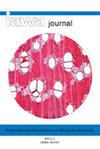Anatomical and topochemical features of the genera Acacia, Acaciella, Senegalia and Vachellia
IF 3.5
3区 农林科学
Q2 FORESTRY
引用次数: 1
Abstract
Molecular research has shown that the genus Acacia is in fact polyphyletic. The discussion about grouping the species of Acacia s.l. into monophyletic genera kept two International Botanical Congresses (Congresses 17 and 18) occupied and resulted in the general acceptance of the genera Acacia, Acaciella, Mariosousa, Senegalia and Vachellia. This raises questions about whether the wood of these new genera can be distinguished using established wood identification methods. Anatomical features of members from Acacia, Acaciella, Senegalia and Vachellia were examined and compared using transmission light microscopy. Topochemical characteristics were investigated using UV microspectrophotometry (UMSP) to identify differences in the distribution of phenolic compounds and cell wall lignification. The current study shows that the presence as well as the arrangement and dimensions of the axial parenchyma, as well as the height and width of the wood rays and fibre dimensions allow anatomical differentiation of the species studied. UMSP revealed the presence and distribution of phenolic compounds and differences in the degree of lignification between the genera. The aim of this paper is to highlight the potential of the applied methods to differentiate between the genera.金合欢属、金合欢属、金合欢属和金合欢属的解剖和地形化学特征
分子研究表明,金合欢属实际上是多系的。关于将金合欢属划分为单系属的讨论持续了两次国际植物学大会(第17届和第18届大会),并导致金合欢属、Acaciella属、Mariosousa属、Senegalia属和Vachellia属被普遍接受。这就提出了一个问题,即这些新属的木材是否可以用现有的木材鉴定方法来区分。利用透射光学显微镜对金合欢、金合欢、塞内加利亚和金合欢的解剖特征进行了研究和比较。利用紫外显微分光光度法(UMSP)研究了拓扑化学特征,以确定酚类化合物分布和细胞壁木质化的差异。目前的研究表明,轴向薄壁组织的存在以及排列和尺寸,以及木材射线和纤维尺寸的高度和宽度允许所研究物种的解剖分化。UMSP揭示了酚类化合物的存在和分布以及属间木质素化程度的差异。本文的目的是突出应用方法的潜力,以区分属。
本文章由计算机程序翻译,如有差异,请以英文原文为准。
求助全文
约1分钟内获得全文
求助全文
来源期刊

IAWA Journal
农林科学-林学
CiteScore
3.40
自引率
15.80%
发文量
26
审稿时长
>36 weeks
期刊介绍:
The IAWA Journal is the only international periodical fully devoted to structure, function, identification and utilisation of wood and bark in trees, shrubs, lianas, palms, bamboo and herbs. Many papers are of a multidisciplinary nature, linking
 求助内容:
求助内容: 应助结果提醒方式:
应助结果提醒方式:


